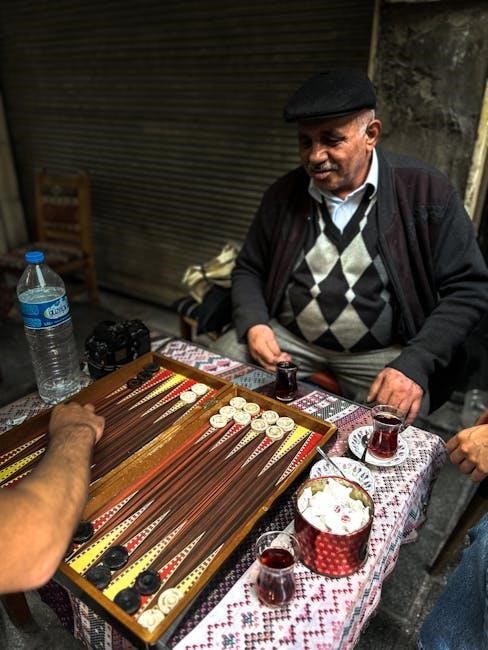Backgammon is an ancient board game combining strategy and luck, played on a 24-point board with checkers and dice. Its rich history spans thousands of years, offering timeless entertainment for players worldwide.
1.1. Overview of the Game
Backgammon is a two-player board game played on a 24-point board with checkers and dice. Players move their pieces clockwise, aiming to be the first to bear off all checkers. The game combines strategy and luck, requiring skillful use of dice rolls to outmaneuver opponents. Its fast-paced nature and deep tactical possibilities make it a beloved game worldwide, suitable for players of all ages and skill levels.
1.2. Historical Background
Backgammon has a rich history dating back thousands of years. Originating in ancient Mesopotamia, it evolved through various civilizations, including the Egyptians, Romans, and Persians. Known as the “royal game,” it became popular in aristocratic circles. By the 18th century, modern rules emerged, solidifying its global appeal. Its enduring legacy as one of the world’s oldest board games reflects its timeless entertainment value and strategic depth.
1.3. Why Learn Backgammon?
Learning backgammon enhances strategic thinking, improves decision-making, and boosts analytical skills. It fosters patience and adaptability, making it a valuable mental exercise. The game’s social aspect encourages connection and healthy competition, while its historical significance offers cultural enrichment. Mastering backgammon can be a rewarding hobby, providing hours of intellectual stimulation and enjoyment for players of all ages and skill levels.
Equipment Needed
The game requires a backgammon board, 15 checkers for each player, two dice, and a doubling cube. These tools ensure proper gameplay and strategy execution.
2.1. The Backgammon Board
The backgammon board features 24 narrow triangles, called points, arranged in alternating colors. These points are divided into four quadrants: the player’s home board, the outer board, the opponent’s home board, and the opponent’s outer board. The board’s design facilitates strategic movement and is essential for gameplay, providing a clear path for checkers to advance and bear off successfully.
2.2. Checkers (Pieces)
Backgammon uses 30 checkers, divided into two sets of 15, typically in contrasting colors like black and white. These pieces are usually made of plastic, wood, or other materials. Players move their checkers clockwise around the board, with the goal of bearing them off. Checkers are essential for blocking opponents and forming primes, which are vital for controlling the game flow and advancing toward victory.
2.3. Dice and Doubling Cube
The game uses four dice (two for each player) and a doubling cube to determine moves and increase stakes. Players roll the dice to advance their checkers, with each die showing the number of points to move. The doubling cube, initially set at 64, allows players to double the stakes during the game, adding strategic depth and potential for higher rewards or losses, enhancing the game’s excitement and complexity.
Setting Up the Game
The board is divided into four quadrants, with checkers placed in specific starting positions. Players arrange their pieces according to the game’s initial setup rules, ensuring proper alignment for gameplay.
3.1. Arranging the Board
The backgammon board is divided into four quadrants: the player’s home board, the opponent’s home board, and two outer boards. Each quadrant contains six triangular points, alternating in color. The board is placed between the two players, with the home boards on the near sides. The doubling cube is typically placed in the center, initially set to 64. The bar separates the outer and inner boards, holding checkers that have been hit during play.
3.2. Placing the Checkers
Each player begins with 15 checkers, placed on specific points of the board. The initial setup follows a standard arrangement: two checkers on the 24-point, three on the 23-point, five on the 22-point, and five on the 13-point for one player. The opponent mirrors this setup on their respective points. The checkers are positioned according to these rules to ensure a balanced and fair start to the game, maintaining symmetry across the board.
3.3. Initial Roll to Determine the First Player
To start the game, each player rolls one die. The player with the higher number goes first. If both players roll the same number, they roll again until one achieves a higher result. This initial roll not only determines the starting player but also sets the tone for the game, ensuring a fair and random beginning to the competition. The dice roll is a crucial first step in the gameplay process.

Basic Rules of Movement
Players move checkers forward based on dice rolls, from higher to lower-numbered points. Movement must follow legal rules, ensuring checkers progress strategically around the board efficiently.
4.1. Understanding the Dice Rolls
In backgammon, dice rolls determine checker movement. Each die shows pips indicating how many points a checker can move. Players must use both dice rolls, moving checkers forward accordingly. The sum of the dice dictates possible moves, and checkers must be moved to open points. If no legal move is available for a dice roll, the turn is forfeited. Understanding dice rolls is crucial for strategic gameplay and progression around the board.
4.2. Moving Checkers Forward
In backgammon, checkers are moved forward in a clockwise direction, from higher to lower-numbered points. Each checker must be moved exactly the number of pips shown on the dice. Players can only move checkers to open points or those occupied by their own checkers. If a checker lands on a point with an opponent’s single checker, it is hit and sent to the bar, temporarily out of play. Legal moves must be made if possible.
4.3. Legal Moves and Restrictions
Players must move checkers according to the dice rolls, using each die’s value exactly. If doubles are rolled, each number must be used twice. Checkers can only move to open points or those occupied by their own pieces. A point with one opponent’s checker can be hit, sending it to the bar. Blocked points (two or more opponent’s checkers) cannot be moved to. Hitting is mandatory if possible, and checkers on the bar must re-enter before other moves. Legal moves prioritize hitting and advancing toward the home board.
Bearing Off
Bearing off is the final stage where players remove all checkers from the board. Players must move checkers to their home board and off according to dice rolls.
5.1. Entering the Home Board
Entering the home board requires strategic positioning of checkers. Players must ensure all pieces are moved to their respective home quadrants before bearing off. Proper placement is crucial for efficient removal, and legal moves are determined by dice rolls. Mastery of this phase is essential for winning the game effectively.
5.2. Removing Checkers from the Board
Once all checkers are in the home board, players begin bearing them off by rolling matching dice. Each die corresponds to a checker’s removal from the respective point. The process requires precise rolls, and the first player to remove all checkers wins. Efficiency and strategic planning are vital to secure victory in this final phase of the game.

Advanced Strategies
Mastering advanced techniques like hitting, blocking, and priming is crucial for experienced players. These strategies enhance gameplay and increase chances of winning by outmaneuvering opponents effectively.
6.1. Hitting and Blocking
Hitting involves capturing an opponent’s checker by landing on a point with only one of their pieces. Blocking is a defensive strategy where you place two or more checkers on a point to hinder your opponent’s movement. Both techniques require precise timing and foresight to execute effectively, making them essential for advanced players aiming to control the game’s momentum and pressure their opponent.
6.2. Using the Doubling Cube
The doubling cube is a key strategic element in backgammon, allowing players to double the stakes of the game. It starts at 64 and can be used by either player during their turn to increase the game’s value. Using the cube wisely can shift momentum, but it also carries risk. Players must weigh the potential benefits against the increased pressure to win, making it a crucial tactical decision in competitive play.

Common Mistakes to Avoid
Avoid moving checkers incorrectly and ignoring opponents’ strategies. Failing to plan ahead and misusing the doubling cube can lead to unnecessary losses, hindering your progress in the game.
7.1. Moving Checkers Incorrectly
Moving checkers incorrectly is a common mistake. Players often move checkers in the wrong direction or fail to follow dice rolls properly, leading to illegal moves. Forgetting to use both dice when possible or not moving the correct number of points can result in penalties. Additionally, landing on occupied points without proper strategy can lead to unnecessary captures. Always double-check your moves to avoid these errors and improve your gameplay.
7.2. Ignoring Opponent’s Moves
Ignoring your opponent’s moves is a critical mistake in backgammon. Failing to observe their strategy can leave you vulnerable to hits and blocking tactics. Always monitor their checker placements and dice rolls to anticipate their next moves. Understanding their actions helps you adjust your strategy, preventing them from gaining an advantage. Stay attentive to maintain control and increase your chances of winning the game effectively.
Tips for Improvement
Analyze your games to identify mistakes, experiment with new strategies, and stay focused. Keep the game in perspective to enjoy continuous learning and improvement.
8.1. Practicing Regularly
Consistent practice is key to mastering backgammon. Dedicate time daily to play and review games, focusing on strategic moves and understanding probabilities. Regular play sharpens intuition and decision-making, helping you adapt to various scenarios and opponents. Use online platforms or local groups to engage in frequent matches, ensuring steady progress and enjoyment of the game.
8.2. Studying Game Tactics
Enhance your skills by studying established backgammon strategies and analyzing expert plays. Focus on key concepts like hitting, blocking, and bearing off. Reviewing game theories and tactics helps refine your decision-making. Utilize guides and videos to explore advanced techniques, ensuring a well-rounded understanding of the game. This dedicated study will elevate your play and improve your chances of success in competitive matches.
Etiquette and Sportsmanship
Respect your opponent, follow rules, and maintain a positive attitude. Congratulate the winner and accept defeat gracefully, ensuring a enjoyable experience for both players.
9.1. Respecting Opponents
Respecting your opponent is crucial in backgammon. Always congratulate the winner and accept defeat gracefully. Avoid gloating or making disrespectful remarks, as this can spoil the game’s enjoyment. Maintain focus on the game without distracting your opponent. Remember, sportsmanship enhances the overall experience, ensuring a positive and fair environment for both players to enjoy the game.
9.2. Following Game Rules
Adhering to the rules is essential for a fair and enjoyable game. Ensure all moves are legal, and avoid unauthorized actions. Always roll dice correctly and move checkers according to the numbers shown. Properly handle the doubling cube and bear off process. Familiarize yourself with standard rules to maintain consistency and avoid disputes. Following rules ensures a competitive yet respectful environment, fostering trust and fairness between players.
Backgammon is a game of skill and chance, requiring strategic movement of checkers around the board. Start playing today and enjoy this timeless classic!
10.1. Summary of Key Points
Backgammon is a two-player game played on a 24-point board with checkers and dice. The goal is to move all checkers to your home board and bear them off first. Understanding dice rolls, legal moves, and strategic tactics like hitting and blocking is essential. Practice and studying improve skills, while etiquette ensures fair play. This timeless game combines skill and luck, offering endless entertainment for players of all ages.
10.2. Encouragement to Play
Backgammon is a rewarding game that combines strategy and social interaction. It’s a great way to challenge your mind, connect with friends, and enjoy a fun, competitive experience. Whether you’re a beginner or an experienced player, backgammon offers endless opportunities to learn and grow. Embrace the excitement of rolling the dice, making tactical moves, and outsmarting your opponent. Start your backgammon journey today and discover why it’s a beloved game for centuries!
